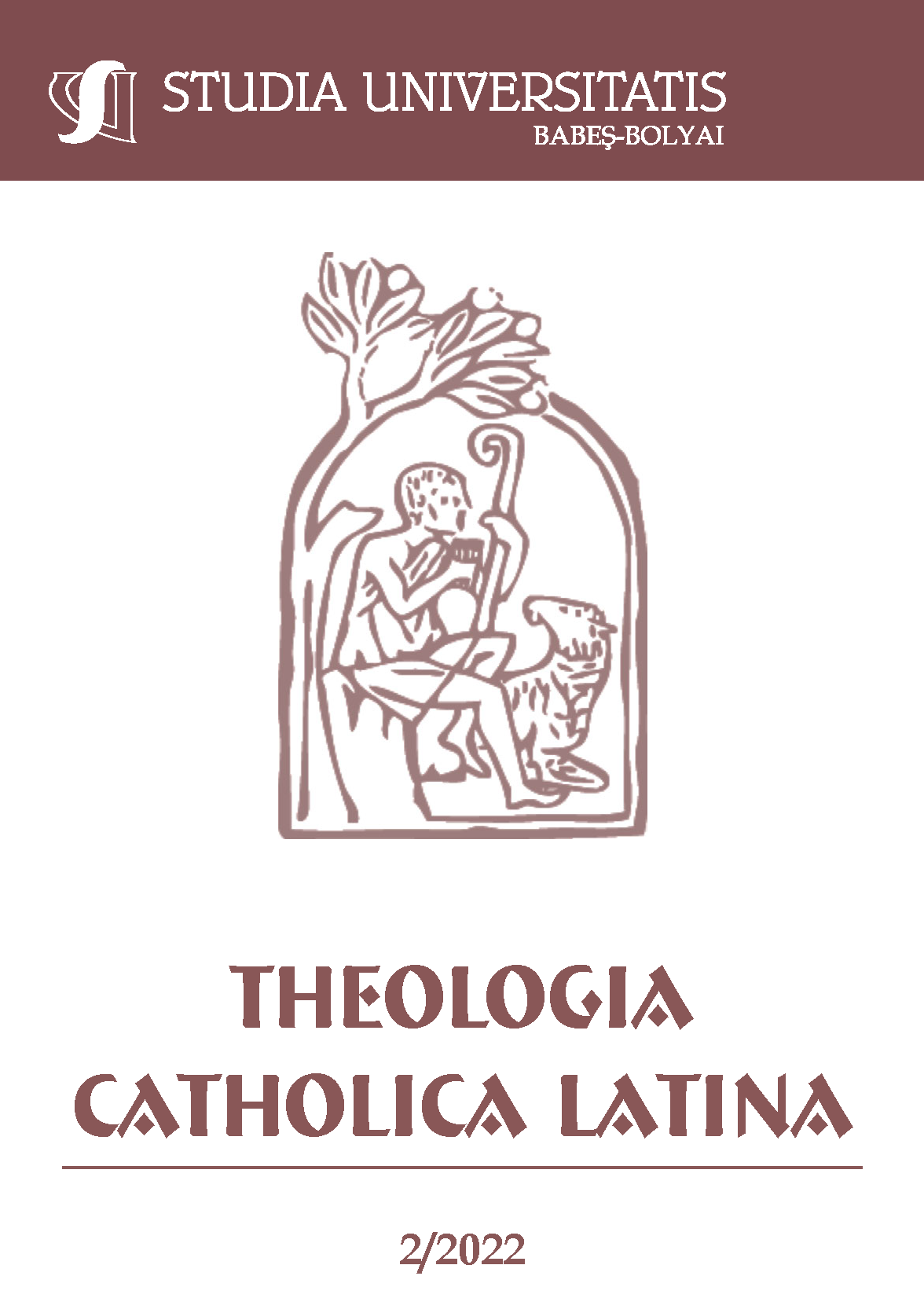SOME ASPECTS OF THE INTEGRATION OF THE ROMAN CATHOLIC DIOCESE OF ALBA IULIA IN THE ROMANIAN ECCLESIAL STRUCTURES IN THE INTERWAR PERIOD
DOI:
https://doi.org/10.24193/theol.cath.latina.2022.LXVII.2.05Keywords:
Concordat, Holy see, Romania, Bishop Mailáth, Transylvania, Catholic Church, Hungarian minority.Abstract
This paper addresses the changes that took place after World War I in the life of the Roman Catholic Diocese of Alba Iulia led by Bishop Gusztáv Károly Mailáth. This was the only new diocese in Romania to retain all the historical territory it had previously held in the Austro-Hungarian Monarchy, whereas all others that have suffered significant territorial losses. The Roman Catholic Church in Transylvania was largely ethnically Hungarian. The diocese was thus faced with the challenge of integrating in the Romanian ecclesiastical-administrative structures, while preserving its religious and ethnic characteristics. We are witnessing here the beginning of a “diplomatic game” between the Romanian Government, the Holy see and Bishop Mailáth. The issue at stake for the Roman Catholic Church in Transylvania was the preservation of confessional and ethnic identity in a new political framework. The integration culminated with the signing of the Concordat between Romania and the Holy see in 1927, but the road to the completion of this document is marked by many interesting developments, which provide an insight in the challenges of preserving confessional and ethnic identity while accommodating to new political circumstances and redefining the mission of a Catholic Church belonging to an ethnic minority.References
Primary sources:
Archives of the Archbishopric of Alba Iulia:
Letter of Elemér Gyárfás to Bishop Gusztáv Károly Mailáth, AAAI, V.5. Personal legacy of Gusztáv Károly Mailáth. a.1. Letters. 16.06.1926.
Letter of the Agrarian Council of Alba County to Bishop Gusztáv Károly Mailáth, AAAI, I.13.e. Various documents, 161/919.13.11.1919.
Letter to Senate’s President, AAAI, V.5. Personal legacy of Gusztáv Károly Mailáth. a.1. Letters. a.1. Letters. 30.10.1926.
Letter of Bishop Mailáth to Elemér Gyárfás, AAAI, V.5. Personal legacy of Gusztáv Károly Mailáth. a.1. Letters. a.1. Letters. 26 02.1925.
Letter of Bishop Mailáth to Elemér Gyárfás, AAAI, V.5. Personal legacy of Gusztáv Károly Mailáth. a.1. Letters. a.1. Letters. 17.06.1926.
Letter of Bishop Mailáth to Elemér Gyárfás, AAAI, V.5. Personal legacy of Gusztáv Károly Mailáth. a.1. Letters. a.1. Letters. 03.12.1926.
Archives of the Archbishopric of Esztergom-Budapest:
Az erdélyi rom. kath. közönség memoranduma az elszakítás ellen [Memorandum of the Roman Catholic community against the break-up], AAEBP, 1407/1920.51. 01.05.1920.
Letter of Jules Cambon to Léon-Adolphe Amette, Archbishop of Paris, AAEBp, 672/1920 D/c. 20.01.1920.
National Archives of Hungary, Documents of the Ministry of Foreign Affairs:
A Bukaresti katolikus egyházmegye magyar anyanyelvű híveinek [To the Hungarian-speaking faithful of the Catholic Diocese of Bucharest], NAH, K105 Embassy at Vatican, 39. box: 1920–1931. R1 Romania, 2584/pol. 02. 05. 1922.
Az erdélyi katolikusok küldöttsége Rómában [The Transylvanian Catholic delegation in Rome], NAH, K105 Embassy at Vatican, 39. box: 1920–1931. R1 Romania, 779/ pol. 8.11.1927.
Glattfelder Gyula csanádi püspök ügye [The case of Bishop Gyula Glattfelder of Csanád], NAH, K105 Embassy at Vatican, 39. box: 1920–1931. R1 Romania 2039/ pol. 15.05.1923.
Majláth erdélyi püspök szenátorsága [Senatorship of Bishop Mailáth of Transylvania], NAH, K105 Embassy at Vatican, 39. box: 1920–1931. R1 Romania, 60/pol. 18.09.1926.
Msrg. Schioppa római látogatása [Visit of Msgr. Schioppa to Rome], NAH, K105, Embassy at Vatican, 35. box, 1929–1932. 19.01.1922.
Journal article:
*, “Auxiliarii cu drept de succesiune ai episcopului Majlath” [Auxiliaries with right of succession to Bishop Majlath], Cuvântul 15.01.1927.
Secondary sources:
Adriányi Gábor, A katolikus egyház története a 20. században Kelet-, Közép-Kelet és Dél-Kelet Európában, Budapest: Kairosz, 2005.
András Szabolcs, “New details regarding the Expulsion of bishop Gyula Glattfelder from Romania”, Studia Theologia Catholica Latina, 1(2016) 87–98.
Beke Margit (ed.), A Magyar Katolikus Püspökkari tanácskozások története és jegyzőkönyvei 1919–1944 között, vol. I., München – Budapest: Aurora, 1992.
Broun, Janice, The Catholic Church in Romania, in Christianity Under Stress II: Catholicism and Politics in Communist Societies, edited by Pedro Ramet, Durham – London: Duke University Press, 1990, 207–212.
Holló László, “Die römisch-Katolische autonomie von Siebenbürgen: der Siebenbürgische römisch-Katolische Status“, Studia Theologia Catholica Latina 2(2012) 3–24.
Holló László, “The Impact of reformation in the Transylvanian diocese and the beginnings of catholic revival”, Studia Theologia Catholica Latina 2(2019) 35– 72.
Jakab Antal, “Az erdélyi római katolikus püspöki szék betöltésének vitája a 17. Században”, Erdélyi Múzeum 49 (1944) 5–20.
Jakab Antonius, De hierarchia Ecclesiae Transsylvaniensis tempore principatus (1527– 1697) (doctoral dissertation), Roma: Pontificia Università Lateranense, 2000.
Keul István, Early Modern Religious Communities in East-Central Europe: Ethnic Diversity, Denominational Plurality and Corporative Politics in the Principality of Transylvania (1526-1691) (Studies in Medieval and reformation Traditions 143) (Studies in Medieval and reformation Traditions), Leiden: Brill, 2009.
Marton József and Jakabffy Tamás, Az erdélyi katolicizmus századai, Kolozsvár: Gloria, 1999.
Miloș, Ofelia, România și Sfântul Scaun în a doua jumătate a secolului al XIX-lea, București: Expert, 2010.
Netzhammer, Raymund, Bischof in Rumänien: im Spannungsfeld zwischen Staat und Vatikan, II (Veröffentlichungen des Südostdeutschen Kulturwerks 771), edited by Nikolaus Netzhammer in collaboration with Krista Zach, München: Verlag Südostdeutsches Kulturwerk, 1996.
Netzhammer, Raymund, Episcop în România, Vol. II, Bucureşti: Editura Academiei Române, 2005.
Nóda Mózes, Biserica Romano-Catolică din Transilvania în perioada interbelică, Cluj-Napoca: Studium, 2008.
Nóda Mózes, “The Historical, Political and Ecclesiastical Background of the 1927 Concordat between the Vatican and Romania”, Journal for the Study of Religions and Ideologies 9.27 (2010) 281–301.
Salacz Gábor, A magyar katolikus egyház a szomszédos államok uralma alatt, München: Aurora, 1975.
Szabó K. Attila (ed.), Az erdélyi magyar tanító- és óvóképzés évszázadai 1777-2000, Marosvásárhely: Mentor, 2009, 55–69.
Szántó Konrád, A katolikus egyház története, vol. I, Budapest: Ecclesia, 1983.
Tóth Krisztián, Az Erdélyi Római Katolikus státus igazgatótanácsának 1873- as újjáalakulása és dualizmus kori tevékenységi köre, Studia Theologica Transylvaniensia 24.2 (2021) 331–360.
Tusor Péter (ed.) Magyarország és a római Szentszék (Források és távlatok), Róma-Budapest: Gondolat, 2012.
Veszely Károly, Erdélyi egyháztörténeti adatok III. Erdélynek a XVI és XVII században országgyűlésileg hozott, vallást tárgyazó törvénycikkei, Kolozsvár, 1860.
Downloads
Published
How to Cite
Issue
Section
License
Copyright (c) 2022 Studia Universitatis Babeș-Bolyai Theologia Catholica Latina

This work is licensed under a Creative Commons Attribution-NonCommercial-NoDerivatives 4.0 International License.



